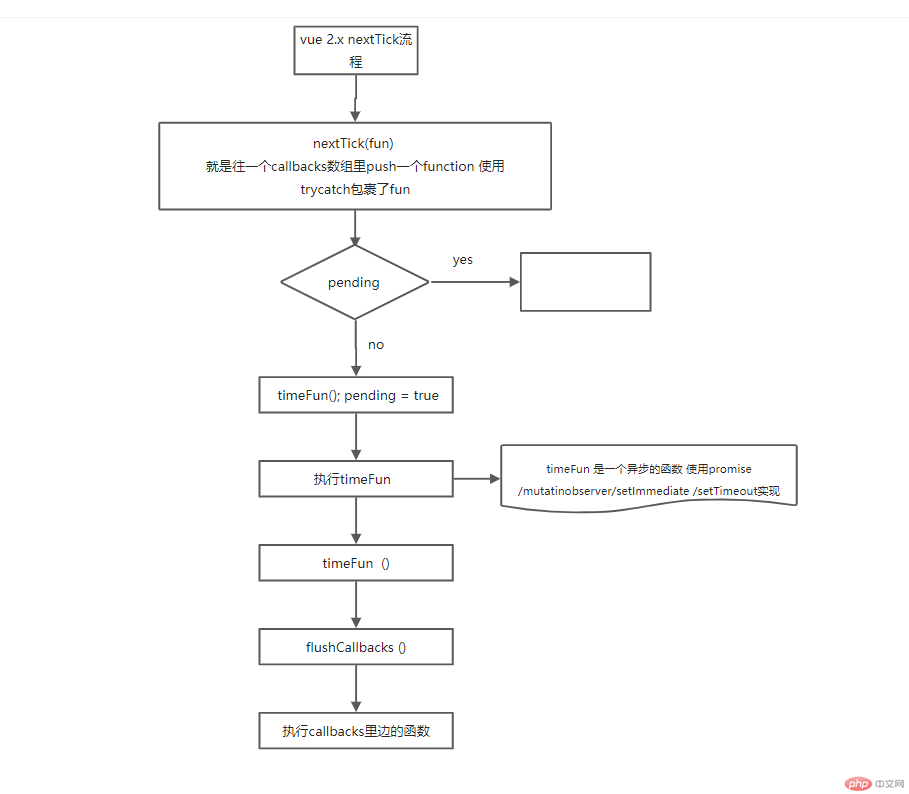接上,说完flushSchedulerQueue之后,我们开始说nextTick:
先扫一眼流程图:

function nextTick (cb, ctx) {
var _resolve;
callbacks.push(function () {
if (cb) {
try {
cb.call(ctx);
} catch (e) {
handleError(e, ctx, 'nextTick');
}
} else if (_resolve) {
_resolve(ctx);
}
});
if (!pending) {
pending = true;
timerFunc();
}
// $flow-disable-line
if (!cb && typeof Promise !== 'undefined') {
return new Promise(function (resolve) {
_resolve = resolve;
})
}
}这个方法实际也是在Vue.prototype.$nextTick里调用的方法,注意这里他将传进来的回调函数用一个匿名函数包裹了一下,然后塞进了callbacks里,这个匿名函数开始执行时,我们用nextTick传进来的函数才会执行。callbacks没啥好说的,一个数组,然后pending置为true,调用timerFunc:
if (typeof Promise !== 'undefined' && isNative(Promise)) {
var p = Promise.resolve();
timerFunc = function () {
p.then(flushCallbacks);
// In problematic UIWebViews, Promise.then doesn't completely break, but
// it can get stuck in a weird state where callbacks are pushed into the
// microtask queue but the queue isn't being flushed, until the browser
// needs to do some other work, e.g. handle a timer. Therefore we can
// "force" the microtask queue to be flushed by adding an empty timer.
if (isIOS) { setTimeout(noop); }
};
isUsingMicroTask = true;
} else if (!isIE && typeof MutationObserver !== 'undefined' && (
isNative(MutationObserver) ||
// PhantomJS and iOS 7.x
MutationObserver.toString() === '[object MutationObserverConstructor]'
)) {
// Use MutationObserver where native Promise is not available,
// e.g. PhantomJS, iOS7, Android 4.4
// (#6466 MutationObserver is unreliable in IE11)
var counter = 1;
var observer = new MutationObserver(flushCallbacks);
var textNode = document.createTextNode(String(counter));
observer.observe(textNode, {
characterData: true
});
timerFunc = function () {
counter = (counter + 1) % 2;
textNode.data = String(counter);
};
isUsingMicroTask = true;
} else if (typeof setImmediate !== 'undefined' && isNative(setImmediate)) {
// Fallback to setImmediate.
// Techinically it leverages the (macro) task queue,
// but it is still a better choice than setTimeout.
timerFunc = function () {
setImmediate(flushCallbacks);
};
} else {
// Fallback to setTimeout.
timerFunc = function () {
setTimeout(flushCallbacks, 0);
};
}timerFunc 是这么定义得,不必细看看就一句话,有microTask就用microTask,否则就用macroTask,然后我们注意到,实际在timerFunc里是传进去了一个叫flushCallbacks的,这个也没啥好说的,因为简单:
function flushCallbacks () {
pending = false;
var copies = callbacks.slice(0);
callbacks.length = 0;
for (var i = 0; i < copies.length; i++) {
copies[i]();
}
}就是用来执行callbacks里push进去的一个个匿名函数的。而这一个个回调,正是一个个watcher update的地方,也是vue视图更新的地方。
终。

